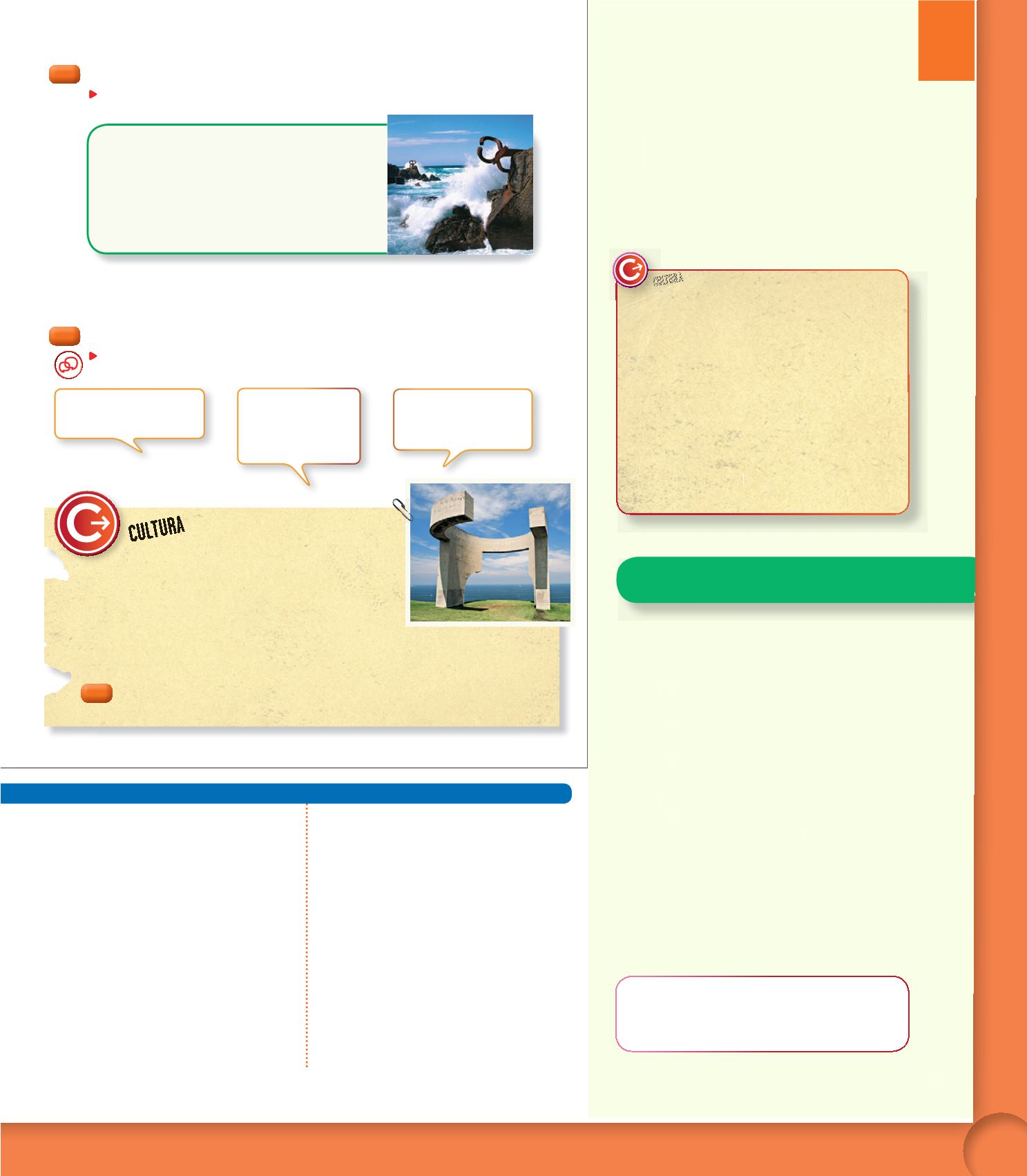

89
43.
In order to provide and evaluate their own
authentic opinions, have students complete
this activity while viewing images of other works
by Chillida (they will find them online). Students
should speak in complete sentences and
include expressions of opinion in their answers.
Answer Key
40.
Estructuras como:
What do you think of...?
How do you feel about...? What’s your opinion
of...? What are your views on...?
41.
1. No pienso que ese puente
se construyera en el siglo
XIII
.
2. No considero que el acueducto
de Segovia sea...
3. No creo que la escultora haya creado...
42.
Answers will vary. Sample answers:
1. ... se adapta al entorno.
2. ... es fuerte y duradera.
3. ... dañe las esculturas.
4. ... muestra la fuerza del mar.
5. ... se oxiden.
6. ... es su simbolismo.
43.
Answers will vary.
44.
Answers will vary.
Gramática – Expresar opinión
DESAFÍO 2
Unit
6
HERITAGE LANGUAGE LEARNERS
r
Have students work with a partner and ask
pairs to select a piece of art, building, piece
of sculpture, or a well-known artist, architect,
or sculptor. Explain to students that they will
create a conversation based on their
opinions of that art, architecture, or its
creator, but one of them will always make
affirmative statements, and the other,
negative ones. If needed, allow students
some time to research the art or artist/
architect in order to make logical and
insightful comments.
MULTIPLE INTELLIGENCES:
Naturalistic Intelligence
r
Ask students to imagine that they are
sculptors and have been thinking about
creating a spectacular sculpture that they
want to integrate with nature in their
community or region. Have students write
several paragraphs that will define and
describe their ideas surrounding the piece
they wish to create. Then, ask them to
mention several places where their art could
be ideally integrated with nature and how it
could be exhibited. Call on volunteers to
share their ideas with the class.
4
2
Peine del viento
Lee
la descripción de esta famosa obra escultórica. Después, completa las oraciones
como si tú fueras el escultor, Eduardo Chillida.
1.
Considero que esta obra...
4.
Me parece que el lugar donde está esta obra...
2.
Supongo que la construcción…
5.
No pienso que los materiales…
3.
No creo que el mar…
6.
Opino que el gran valor de esta obra...
4
3
Opiniones diversas
Lee
las opiniones de estos estudiantes sobre arquitectura y escultura, y coméntenlas
en pequeños grupos. ¿Están de acuerdo con ellas? ¿Por qué?
El
Peine del viento XV
es, probablemente, la obra
más conocida del escultor español Eduardo Chillida.
Es un conjunto de esculturas situado en un extremo
de la bahía de La Concha, en San Sebastián (España).
Lo forman tres esculturas de acero, de 10 toneladas
de peso cada una, incrustadas en unas rocas azotadas
por las olas que dan al mar Cantábrico.
Eduardo Chillida
Eduardo Chillida nació en 1924 en San Sebastián (España).
Abandonó los estudios de Arquitectura para dedicarse al dibujo
y a la escultura, sus grandes pasiones. Empezó esculpiendo
en hierro y madera, pero pronto empezó a experimentar con
materiales como el acero. La naturaleza era para él fuente de
inspiración; de ahí que muchas de sus grandes obras estén
situadas en espacios naturales abiertos.
4
4
Piensa y explica.
Fíjate en las dos fotografías de esta página. ¿Por qué piensas
que Chillida les puso esos títulos a sus obras? ¿Qué nombres les habrías dado tú?
Eduardo Chillida.
Elogio
del horizonte.
Gijón (España).
- & #(!'" ) &'
%' " %!" !" ' ! ! ! 6!
) "% . '
4"&
- 3 !" # %
$( %$( ' '(% &
(! %' " " " &"!
# !'(% " & ( '(% .
4"&
- # !" $( & & ( '(% &
&"! % "&3& &
! !' %3 $( (
'() % (! .
4"&
Additional Resources
Fans Online activities
Practice Workbook
Eduardo Chillida
Eduardo Chillida claimed that space itself
was his main building material. Perhaps for
this reason, most of his sculptures are open-
air pieces. Chillida worked in cement, stone,
steel, and iron, which he forged himself.
There are several sculptures by Chillida in
public places in the United States. Among
them,
Around the Void V
in the courtyard of
the World Bank headquarters in Washington,
D.C. and
De música
, outside the Morton H.
Meyerson Symphony Center in Dallas, TX.
ULTURA
C
321
Book 4 Unit 6


















